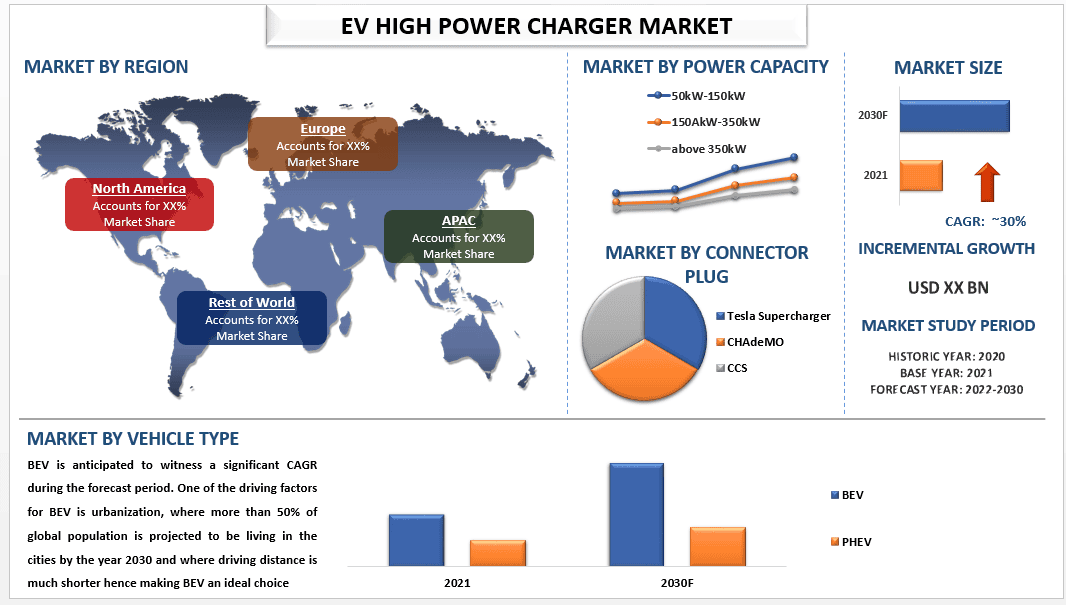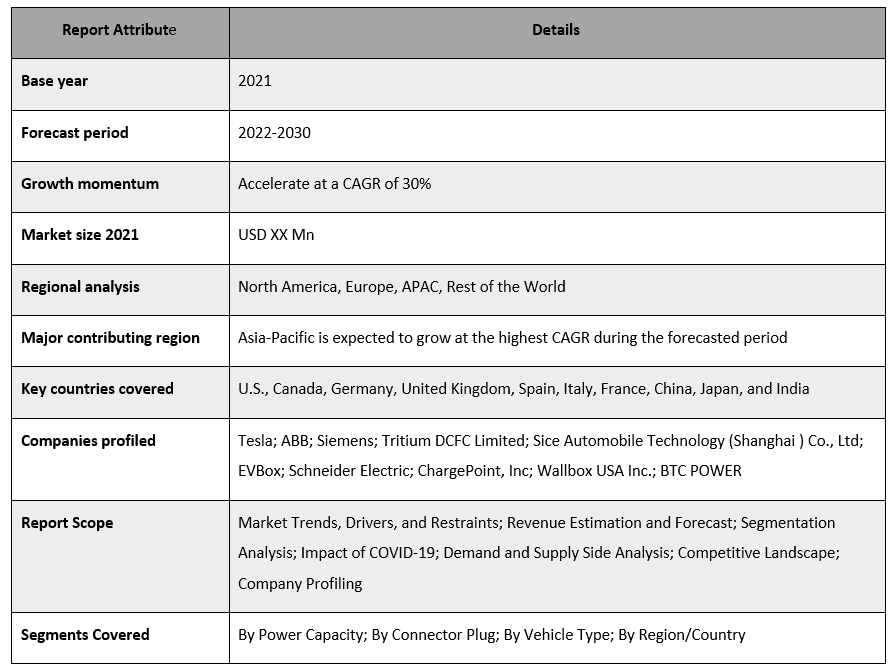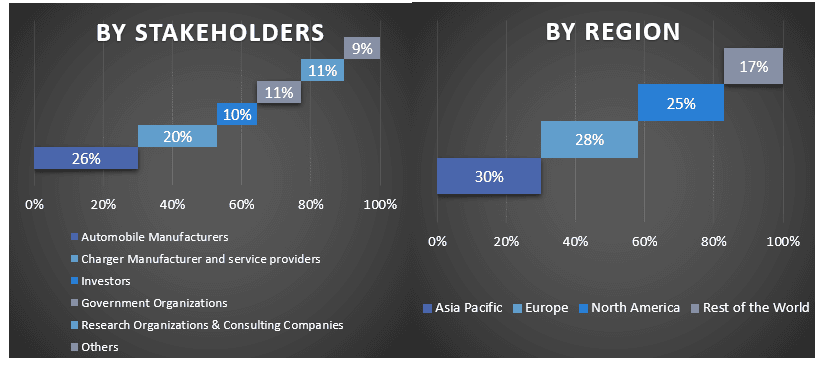- Home
- About Us
- Industry
- Services
- Reading
- Contact Us
EV High Power Charger Market: Current Analysis and Forecast (2022-2030)
Emphasis on Power Capacity (50kw-150kw, 150kw-350kw, and above 350kw), Connector Plug Type (Tesla supercharger, CHAdeMO, and CCS), and Vehicle Type (BEV and PHEV) Region/Country.

The EV high power charger market is expected to grow at a strong CAGR of around 30% during the forecast period.
High power charger refers to the level 3 DC fast charger which can recharge an EV to 80% in about 20-45 minutes. The EV high power charger market includes a range of products such as high power charger of different power capacities, different voltage capacities, in addition high power charger uses different types of operating connector plugs like Tesla supercharger, CHAdeMO, and CCS. Moreover, different mode of businesses are operational in this market where some players are in direct manufacturing of the components and some are operating as a service provider by giving charging as a service(Caas), and lots of state units are also actively involved in this market, developing charging infrastructure at very fast rate.
Electric vehicles are increasing on the roads and it is anticipated that, 120 million BEVs will be sold till 2030, this growth will be driven by declining battery prices and cost of ownership, increase in fleet electrification and focus on achieving emissions targets. With this rising EV customer base, demand for public fast charging is also increasing for its on-the-go use case which delivers charging at highest speed, and to make this on-the-go use case work charger technology is focused on DC high power charger that can deliver power up to 350Kw and more, bringing this EV ecosystem very close to conventional transportation ecosystem by reducing the charging time to as low as 20 minutes which is comparable to what it takes for filling up the gas at the gas station. And because of these factors countries are investing heavily on increasing their fast charger infrastructure. For instance, as per IEA, in 2021 the number of public fast chargers in Europe was up by over 30% to nearly 50 000 units. This includes 9 200 public fast chargers in Germany, 7 700 in the United Kingdom, 6 700 in Norway, 4 500 in France, 2 600 in Spain and in the Netherlands. The United States counts about 22 000 fast chargers, of which nearly 60% are Tesla superchargers. Korea has 15 000 fast chargers, 50% more than in 2020.
Some of the major players operating in the market include Tesla; ABB; Siemens; Tritium DCFC Limited; Sice Automobile Technology (Shanghai ) Co., Ltd; EVBox; Schneider Electric; ChargePoint, Inc; Wallbox USA Inc.; BTC POWER. Several M&As along with partnerships have been undertaken by these players to facilitate customers with hi-tech and innovative products/technologies.
Insights Presented in the Report
“Amongst power capacity type, the 150Kw-350kW segment is expected to grow with the significant CAGR during the forecast period.”
On the basis of power capacity type, the market is segmented into 50kw-150kw, 150kw-350kw, and above 350kw. 150Kw-350Kw segment is anticipated to grow at the highest CAGR. With increased EVs affordability now the major roadblock in the mass adoption EVs are no longer the cost but the charging time where EV drivers want to charge their cars as conveniently as they would refuel an ICE vehicle. And ultra fast charging is the solution for this which can recharge an electric vehicles batteries in less than 30 mins. Moreover, one of the key barriers for the EV adoption is range anxiety with more high power DC fast charger on the road this can no longer be a concern. Additionallly until 2017 virtually all electric vehicles were limited to 50Kw fast charging and most fast charger installed had maximum capacity of 50kw but now manufacturers such as Volkswagen, Audi and Porsche are agreeing with the fact that ultra fast charging is critical for the adoption of electric cars. For instance, in 2017 CharIN released the specifications of an enhanced CCS standard that allows charging up to 350 kW. That’s up to seven times faster than a 50 kW charger reducing the time to charge 250 kilometers of range from one hour to less than 10 minutes.
“Amongst vehicle type, the BEV segment holds the significant market share in the year 2021”
Based on vehicle type, the market is bifurcated into BEV and PHEV. BEV segment holds the highest market share and is also anticipated to witness the highest CAGR during the forecast period. The growing factors such awareness about environmental concerns among the consumers, rising number of choices of electric vehicles in the market which used to be very concentrated in the past and rapid urbanization is fueling this growth. Moreover, BEV being full electric and with increasing value proposition offered by an electric vehicle, with decreasing cost, and increasing range along with rising fast charging infrastructure, is loved more by the consumers than PHEVs.
EV high power charger Market Report Coverage

“Asia Pacific dominated the EV high power charger market in 2021.”
The EV high power charger market in the Asia Pacific region held the largest market share and is expected to maintain its growth throughout the forecast period. With rising electric vehicles market the need for charging infrastructure has become a necessity and governments are being very proactive about it as they have prioritized reducing tailpipe emissions in their countries which account for the major GHG emissions For instance, as per IEA, China has set a target of having 40% of the vehicles sold in the nation be EVs by 2030, which means that a lot more vehicles will need to be charged. The government intends to have charging infrastructure in place by 2025 to satisfy the needs of more than 20 million cars, and China is the global leader in the number of publicly available chargers as of 2020. It has approximately 85% of the world’s fast chargers and 55% of the slow ones. This represents China’s demonstrated leadership in the EV sector, as well as the country’s extremely dense urbanization.
Reasons to buy this report:
- The study includes market sizing and forecasting analysis validated by authenticated key industry experts.
- The report presents a quick review of overall industry performance at one glance.
- The report covers an in-depth analysis of prominent industry peers with a primary focus on key business financials, product portfolios, expansion strategies, and recent developments.
- Detailed examination of drivers, restraints, key trends, and opportunities prevailing in the industry.
- The study comprehensively covers the market across different segments.
- Deep dive regional level analysis of the industry.
Customization Options:
The global EV high power charger market can further be customized as per the requirement or any other market segment. Besides this, UMI understands that you may have your own business needs, hence feel free to connect with us to get a report that completely suits your requirements.
Table of Content
Research Methodology for the EV High Power Charger Market Analysis (2022-2028)
Analyzing the historical market, estimating the current market, and forecasting the future market of the global EV high power charger market were the three major steps undertaken to create and analyze the adoption of energy cyber security in major regions globally. Exhaustive secondary research was conducted to collect the historical market numbers and estimate the current market size. Secondly, to validate these insights, numerous findings and assumptions were taken into consideration. Moreover, exhaustive primary interviews were also conducted, with industry experts across the value chain of the global EV high power charger market. Post assumption and validation of market numbers through primary interviews, we employed a top-down/bottom-up approach to forecasting the complete market size. Thereafter, market breakdown and data triangulation methods were adopted to estimate and analyze the market size of segments and sub-segments of the industry pertains to. Detailed methodology is explained below:
Analysis of Historical Market Size
Step 1: In-Depth Study of Secondary Sources:
Detail secondary study was conducted to obtain the historical market size of the EV high power charger market through company internal sources such as annual reports & financial statements, performance presentations, press releases, etc., and external sources including journals, news & articles, government publications, competitor publications, sector reports, third-party database, and other credible publications.
Step 2: Market Segmentation:
After obtaining the historical market size of the EV high power charger market, we conducted a detailed secondary analysis to gather historical market insights and share for different segments & sub-segments for major regions. Major segments are included in the report as power capacity, connector plug type, and vehicle type. Further country-level analyses were conducted to evaluate the overall adoption of testing models in that region.
Step 3: Factor Analysis:
After acquiring the historical market size of different segments and sub-segments, we conducted a detailed factor analysis to estimate the current market size of the EV high power charger market. Further, we conducted factor analysis using dependent and independent variables such as power capacity, connector plug type, and vehicle type of the EV high power charger market. A thorough analysis was conducted for demand and supply-side scenarios considering top partnerships, mergers and acquisitions, business expansion, and product launches in the EV high power charger market sector across the globe.
Current Market Size Estimate & Forecast
Current Market Sizing: Based on actionable insights from the above 3 steps, we arrived at the current market size, key players in the global EV high power charger market, and market shares of the segments. All the required percentage shares split, and market breakdowns were determined using the above-mentioned secondary approach and were verified through primary interviews.
Estimation & Forecasting: For market estimation and forecast, weights were assigned to different factors including drivers & trends, restraints, and opportunities available for the stakeholders. After analyzing these factors, relevant forecasting techniques i.e., the top-down/bottom-up approach were applied to arrive at the market forecast for 2030 for different segments and sub-segments across the major markets globally. The research methodology adopted to estimate the market size encompasses:
- The industry’s market size, in terms of revenue (USD) and the adoption rate of the EV high power charger market across the major markets domestically
- All percentage shares, splits, and breakdowns of market segments and sub-segments
- Key players in the global EV high power charger market in terms of products offered. Also, the growth strategies adopted by these players to compete in the fast-growing market
Market Size and Share Validation
Primary Research: In-depth interviews were conducted with the Key Opinion Leaders (KOLs) including Top Level Executives (CXO/VPs, Sales Head, Marketing Head, Operational Head, Regional Head, Country Head, etc.) across major regions. Primary research findings were then summarized, and statistical analysis was performed to prove the stated hypothesis. Inputs from primary research were consolidated with secondary findings, hence turning information into actionable insights.
Split of Primary Participants in Different Regions

Market Engineering
The data triangulation technique was employed to complete the overall market estimation and to arrive at precise statistical numbers for each segment and sub-segment of the global EV high power charger market. data was split into several segments & sub-segments post studying various parameters and trends in the areas of the product, technology, and end-users in the global EV high power charger market.
The main objective of the Global EV High Power Charger Market Study
The current & future market trends of the global EV high power charger market were pinpointed in the study. Investors can gain strategic insights to base their discretion for investments on the qualitative and quantitative analysis performed in the study. Current and future market trends determined the overall attractiveness of the market at a regional level, providing a platform for the industrial participant to exploit the untapped market to benefit from a first-mover advantage. Other quantitative goals of the studies include:
- Analyze the current and forecast market size of the EV high power charger market in terms of value (USD). Also, analyze the current and forecast market size of different segments and sub-segments
- Segments in the study include areas of the power capacity, connector plug type, and vehicle type.
- Define and analysis of the regulatory framework for the energy cyber security industry
- Analyze the value chain involved with the presence of various intermediaries, along with analyzing customer and competitor behaviors of the industry
- Analyze the current and forecast market size of the EV high power charger market for the major region
- Major countries of regions studied in the report include Asia Pacific, Europe, North America, and the Rest of the World
- Company profiles of the EV high power charger market and the growth strategies adopted by the market players to sustain in the fast-growing market
- Deep dive regional level analysis of the industry
Related Reports
Customers who bought this item also bought










